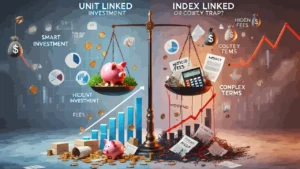Here is a basic overview based on the experience I have acquired so far in the world of markets and investments, which allow me to generate capital gains to live and sometimes indulge myself.
I am not a financial advisor:
The information provided does not constitute a solicitation for the placement of personal savings. The use of the data and information contained as support for personal investment operations is at the complete risk of the reader.
Contents
#1. Currency and Deposits 💵
Many will not expect it, but when you are not invested in anything, and you keep your liquidity in a current account or in cash, you are invested… in currency! It means being invested in a medium of exchange issued by a bank and used in a specific geographical area for the exchange of goods and services.
Although currency may be perceived as a safe haven for protecting one’s capital, in reality it is not at all because, being money, it will always depreciate over time.
If you are interested in buying currencies from other countries you can do it in 3 ways:
- In cash in banks or inside airports or some train stations,
- On an account enabled to convert and hold foreign currencies,
- By buying government bonds issued in the currency you want to purchase.
Current accounts are protected in many european countries by law for up to 100 thousand euros of liquidity for each account holder for each bank through a special guarantee fund.
👉 Read also: Why the 100k Euros Are Safe on a Current Account
Deposit accounts and certificates
Some credit institutions offer the possibility of committing liquidity in a deposit account or deposit certificats in parallel with the current account. They can be withdrawable or tied up until maturity. They generate income proportional to their duration and in line with the interest rates of the moment.
Usually the most advantageous deposit accounts are those aimed at potential new customers of a bank. They are protected up to 100 or 200 thousand euros, depending on the country, like current accounts.
#2. Bonds (debt securities) 📆
Bonds, issued by companies in the form of corporate bonds or by States in the form of Government Bonds (government bonds), are loans made in exchange for an interest called coupon, usually fixed over time. At the maturity of this loan, the capital initially lent will be returned.
The greatest risk you are exposed to when buying bonds is the bankruptcy of the issuer (company or government) with the almost certain consequence of the partial or total loss of the loan. To minimize this risk, it is advisable to buy bonds with an “Investment Grade” rating or at least BBB (S&P Rating). Usually, a high interest rate compared to other bonds also implies a greater risk of insolvency.
👉 Read also: Logical Analysis of Government Bonds
They can be purchased individually or in the form of funds. Although the underlying is the same, the operating mechanism differs between the two solutions. In fact, individual bonds have a maturity date that is fixed and unchangeable, while bond funds do not mature and the bonds that compose it expire sooner or later. Consequently, the funds must exclude all those bonds that are about to expire and always buy or sell new bonds. Simply put, the variation in interest rates over time does not guarantee the value of a bond fund at a given date, unlike a single bond at maturity.
The only exception is fixed-term bond funds. In simple terms, they are funds with a limited duration linked to the maturity of the bonds contained within. In this way, the value of the fund gets closer and closer to the nominal value of the underlying assets as their maturity approaches.
Generally speaking, bonds allow you to keep pace with inflation and sometimes generate a little extra income.
Personally, I would prefer gold to this type of investment because, starting from the medium term, it offers higher returns and lower risks. However, if you need certain returns and no risk on your capital in a certain period of time, then bonds would be the ideal solution.
Classification of corporate bonds
Corporate bonds are primarily classified by the nature of their behavior or composition:
- Zero coupon: they do not pay coupons but are issued at a lower price (below par) than the redemption price at maturity.
- Structured: they have a variable return and are created by combining an ordinary bond with one or more derivative contracts.
- Convertible: those who own them have the option of deciding whether to remain a creditor of the issuing company for the entire duration of the loan, or whether, during certain periods, to convert them into shares.
- Convertende: as before, but the conversion is already established.
- Subordinated: the payment of coupons and the repayment of capital, in the event of particular financial difficulties of the issuer, depend on the satisfaction of other non-subordinated creditors (or subordinated of a lower level). They yield more but are riskier and are divided into other subcategories, based on risk and return.
Classification of government bonds
Government bonds are mainly classified according to duration and have different names depending on the country that issues them.
In the United States of America there are:
- Treasury bills (T-bills): 4 weeks to 12 months
- Treasure notes (T-notes): from 2 to 10 years
- Treasury bonds (T-bonds): 10 to 30 years
Other famous government bonds are the German Bund and the Spanish BONOS.
#3. Stocks (equity securities) 📈
Buying shares means buying a piece of a company (public or private) and receiving during the year part of the profits (dividends) that the company’s board of directors decides to redistribute among the shareholders.
They can be classified as ordinary, preferred and savings shares. The last two give little or no voting power at the meeting but in compensation higher dividends. Today, however, almost all shares are ordinary.
The greatest risk is linked to a fall in the share price on the market and, in the most extreme case, to the bankruptcy of the issuing company , a scenario in which shareholders are among the most exposed.
You can buy them individually or as funds, but unlike bond funds, the operating mechanism is practically the same.
A good strategy could be to invest in global equity funds or in sector/thematic funds (a riskier choice because it concentrates the capital in a particular sector).
So far, in the medium to long term, stocks have proven to be a good way to generate consistent income and more than revalue one’s capital in the face of inflation.
REIT, real estate in the stock market
A special class of shares are REITs (Real Estate Investment Trusts) that are companies that operate in the real estate market, listed on the stock exchange and that deal with the purchase, sale and rental of real estate. They are required to distribute at least 90% of their taxable income in the form of dividends to shareholders, thus ensuring a constant flow of income.
A very common mistake is to confuse REITs with owning real estate. Buying REITs actually means buying pieces of companies (shares, in fact) that operate in the real estate sector and not directly owning buildings, infrastructure or land.
Buying REITs believing you are buying real estate on the stock exchange is a mistake, but at the same time it is the only possible way to gain concentrated exposure to them by operating on the stock exchange.
Private Equity, companies not listed
A stock market theme I would like to spend a few words on is Private Equity. Companies operating in this sector invest in companies not listed on the stock exchange in order to obtain a profit deriving from the future listing of the companies themselves on the stock exchange or from the resale of the acquired shares.
As with REITs, you will not directly own pieces of unlisted companies, but pieces of listed companies that invest in unlisted companies selected by the fund manager himself.
Buying Private Equity believing you are buying companies not listed on the stock exchange is a mistake, but at the same time it is the only possible way to gain concentrated exposure to them by operating on the stock exchange.
#4. Commodities and Metals 🌽
Tend to appreciate in value over time due to inflation and currency devaluation. A good diversified basket helps with this, but unlike precious metals, you can never hold them yourself (unless you have a pretty big warehouse).
They can only be purchased as funds without physical coverage given the difficulty of storage and the deterioration of the underlying.
Precious metals
This subcategory (so to speak) has been more than extensively covered on this channel. In my opinion, gold in particular is the best way to protect yourself from inflation and revalue your capital over time. They are completely free from counterparty risk (if self-held) and can be physically held both at home and in third-party vaults.
They can be purchased in the form of funds but, unlike almost all other investment classes, they can also be purchased and physically held as they are material goods with a high density of value and are non-perishable.
Given taxation and price history, only gold represents a safe haven. All other metals, however, are more suitable for speculation at the moment.
#5. Mutual investment funds 👪
Mutual funds are collective assets in which the savings of multiple investors converge. The main purpose for which they are created is to obtain advantages in terms of performance, minimization of costs, diversification of the portfolio and greater contractual power during the negotiation of individual financial assets. The assets are entirely managed upstream by the Savings Management Company (SGR) that issues and controls them.
There are different types and classifications such as: open-ended funds, closed-ended funds, harmonized funds, pension funds, hedge funds, actively managed funds, passively managed funds, leveraged funds, etc.
However, I believe it is more important to focus on the classification by quotation and by use of profits.
Classification by quotation
- Unlisted funds: can only be traded through an SGR or an intermediary authorized by the latter. They are almost all actively managed and therefore more expensive than the latter. Most have entry, management and exit fees.
- Listed funds: freely negotiable on the stock exchange with any authorized intermediary. They are almost all passively managed and therefore less expensive than the former. They only have management costs, not entry or exit costs. They are also called Exchange Traded Products (ETP), they are divided into:
- Exchange Traded Funds (ETFs): Consisting of stocks, bonds, commodities and real estate.
- Exchange Traded Commodities (ETC): composed of one or more raw materials or precious metals.
- Exchange Traded Notes (ETN): composed of debt securities subordinated to the integrity of the vehicle company. They also allow you to invest in less usual financial products.
Listed funds (or ETPs) are generally better performing instruments because they have much lower management costs, allowing you to minimize losses and maximize profits. They also allow you to invest in a broader basket of underlying assets with a single solution.
Unfortunately, however, most people still turn to the bank’s financial advisor to invest, buying unlisted mutual funds and thus depriving themselves of a slice of the capital gains to give it to the shareholders of the credit institution. In this way, investors earn less when they earn money and lose more when they lose money.
Classification by use of profits
- Accumulation Funds: Profits, whether coupons or dividends, periodically paid by the companies that make up the fund, are automatically reinvested in the fund itself without being subject to any taxation either in the country in which the fund is domiciled or in the country in which the holder of the fund’s shares is tax resident. This method is very useful for maximizing long-term investment and many choose to invest in an accumulation ETP for this very reason instead of buying the shares individually.
- Distribution funds: the same profits are distributed among the fund’s unit holders, proportionally to the number of units owned by each. However, the profits are taxed first in the country in which the fund is domiciled and then in the country in which the holder of the fund’s units is tax resident. This method is preferred by those who want to make short-term profits from their investment. In an attempt to mitigate the phenomenon of double taxation, there are agreements between some states aimed at facilitating the procedure by reducing the rates to be paid. It is no coincidence that almost all funds are always domiciled in the same countries: Ireland and Luxembourg.
Financial insurance policies
They are insurance-financial instruments that, unlike mutual funds, combine investment in financial markets with an insurance component (such as death coverage). They offer tax advantages, the possibility of succession planning and capital protection in the event of insured events, elements that are absent in traditional mutual funds. They are mainly:
- Unit linked: linked to mutual funds, more flexible.
- Index linked: linked to stock market indices, usually less flexible.
These products are in my opinion unnecessarily complicated and expensive, easily replaceable with cheaper and simpler financial instruments.
👉 Read also: Unit and Index Linked: Complexity and High Costs
#6. Derivative instruments 🧮
Derivatives are called this way because their value derives from the trend of the value of an asset or from the occurrence in the future of an objectively observable event. The asset, or the event, which can be of any nature or kind, constitute the underlying of the derivative product. There are mainly 5 types:
Futures and Forwards
Derivative contracts that oblige the parties to buy or sell an underlying asset at a strike price on a future date . Futures are standardized and exchange-traded, while forwards are customizable and over-the-counter (OTC). They have initial margins, daily mark-to-market adjustments, and can be physically or cash settled.
They are used for hedging or speculation and involve leverage. Risk can be high due to volatility and the mandatory position at maturity. They are zero-sum instruments: what one party gains, the other loses. They require active risk management and deep technical knowledge.
Options
Contracts that give the right, but not the obligation, to buy (call) or sell (put) an underlying asset at a strike price by a certain date (expiration) . The buyer of the option pays a premium and has limited risk to the loss of the premium, while the seller (writer) has potentially unlimited risk. Options can be European (exercisable only at expiration) or American (exercisable at any time). They are traded on both regulated markets and OTC.
Traders use strategies such as spreads, straddles and covered calls. The value of the option is influenced by factors such as volatility, time decay, interest rates and the price of the underlying. They are complex instruments with high speculative and hedging potential.
Covered warrant
Identical to options in terms of operation, but they are traded on the stock exchange like shares and their price depends on intrinsic value and time . They have an issuer that guarantees coverage (covered), reducing counterparty risk. They are leveraged instruments: small movements in the underlying can cause large price variations.
Often used for short-term speculation, but can also be used for hedging. They involve the risk of total loss of the invested capital. They have transparency thanks to the listing on official markets, but the issuer can withdraw them early (knock-out or callability).
Certificates
Derivative financial instruments issued by banks, linked to an underlying asset (shares, indices, currencies, commodities) that replicate or modify the performance of the underlying . They do not give ownership rights on the underlying but follow its performance according to a predefined structure (e.g. protected capital, leverage, conditional return). Some common types: Bonus, Twin Win, Express, Reverse. They can have barrier (barrier) or capital protection mechanisms (capital protection).
They are instruments listed on the stock exchange and often used for passive or speculative strategies. The return may depend on whether or not certain levels of the underlying are exceeded. They are transparent but with issuer risk. Taxation and structure are often complex.
Contract for differences
OTC derivative contracts that replicate the price variation of an underlying asset without owning it . The investor and the broker exchange the difference between the opening and closing prices of the position. They allow you to operate upwards (long) or downwards (short), with large financial leverage (leverage), therefore with amplified risks and profits. There are no fixed deadlines, but daily maintenance costs (overnight fees).
They are used for short-term speculation on stocks, indices, currencies, cryptocurrencies and more. They boast high flexibility but expose to significant risks, including the possibility of losses greater than the invested capital if stop-loss is not used. Regulated by local authorities but not always transparent.
#7. Financial indicators 🧭
In the world of finance, several key indicators help assess the quality, risk, and return of mutual funds, ETFs, and stocks. Understanding these metrics allows investors to make more informed decisions. Below are the main ones, explained in simple terms with practical examples.
NAV (Net Asset Value)
NAV represents the value of a single share of a mutual fund or ETF. It is calculated by dividing the fund’s total net assets by the number of shares outstanding. It is updated daily based on market movements to reflect the actual value of each share.
Example: If a fund holds assets worth €10 million and has issued 1 million shares, the NAV is €10 per share. This helps the investor understand whether they are buying or selling at a fair price.
Net Asset Value of the Fund (AUM)
The fund’s net assets, also known as Assets Under Management (AUM), represent the total value of the fund’s holdings minus its liabilities. This includes stocks, bonds, cash, and other instruments. It gives an idea of the overall size of the fund and its capacity to attract investors.
Example: If a fund holds securities worth €100 million and has liabilities of €2 million, its net assets are €98 million. This amount reflects the real wealth of the fund available to investors.
Dividend Yield
The dividend yield measures the annual return from dividends relative to the current price of a stock. It is obtained by comparing the total annual dividend paid to the stock’s market price. It is useful to evaluate how much income an investment can provide.
Example: If a stock trades at €100 and pays an annual dividend of €5, the dividend yield is 5%. This makes it easier to compare different stocks based on their income potential.
Price to Earnings (P/E)
The P/E ratio compares a stock’s market price to the earnings generated per share. It is calculated by dividing the current stock price by its earnings per share (EPS). It shows how much investors are willing to pay today for one euro of the company’s profit.
Example: If a stock costs €40 and the earnings per share are €2, the P/E ratio is 20. This means investors are paying €20 for every euro of annual earnings, which may indicate strong growth expectations.
Price to Book (P/B)
The P/B ratio compares a stock’s market price with its book value per share. The book value is calculated by dividing the company’s equity by the number of outstanding shares. This indicator helps compare the market value of the company with its theoretical liquidation value.
Example: If a company has a book value per share of €25 and the stock trades at €50, the P/B ratio is 2. This suggests that the market is valuing the company at twice its book value, possibly due to confidence in its future prospects.
Standard Deviation
Standard deviation measures how much a fund’s or stock’s returns vary from their historical average. It is obtained by analyzing how past returns deviate from the average value. A high standard deviation indicates greater variability and therefore higher risk.
Example: A fund with an average annual return of 5% but fluctuations ranging from -10% to +20% has a high standard deviation. This means future returns may differ significantly from the average, increasing perceived risk.
Sharpe Ratio
The Sharpe ratio assesses how much excess return an investment has generated compared to the risk-free rate, considering its volatility. It is calculated by subtracting the risk-free rate from the investment’s return and dividing by the standard deviation. A higher ratio means a better return-to-risk balance.
Example: A fund returning 7% annually compared to a 2% risk-free rate, with a standard deviation of 5%, has a Sharpe ratio of 1. This indicates that the fund is efficient in generating value for each unit of risk.
Beta Index
Beta measures how sensitive a stock or fund is to market movements. It is calculated by comparing the investment’s return variations with those of a reference index. A beta above 1 means greater volatility than the market; below 1 means less.
Example: A fund with a beta of 1.2 tends to rise 12% when the market goes up 10%, and fall more sharply when the market declines. It is therefore more reactive to overall market trends.
TER (Total Expense Ratio)
The TER represents the annual cost investors pay to hold a fund or ETF. It includes all recurring expenses such as management fees and operating costs, relative to the fund’s average assets. The lower the TER, the higher the net return for the investor.
Example: If a fund has a TER of 1.5%, it means the investor pays €15 annually on an investment of €1,000, regardless of performance. Passive funds like ETFs typically have lower TERs than actively managed funds.
#8. Returns, risks and horizons 📊
This table should summarize quite effectively the relationship between the return, risk and the suggested horizon for each asset class. This is my personal assessment, do not take it at face value, but do your necessary research.
| Investment Type | Return | Risk | Suggested Horizon (years) |
|---|---|---|---|
| Currency | negative | almost zero | for emergencies |
| Bonds | low – medium | low for ≥ BBB | 5 – 6 |
| Stocks | high | high | 5 – 15 |
| Gold | medium – high | medium | 5 – 15 |
| Other Precious Metals | low – high | high | 10 – 20 |
| Commodities | low – medium | medium | 5 – 15 |
| Mutual Funds | d.o.u. | d.o.u. | d.o.u. |
| Derivatives | d.o.u. | d.o.u. | d.o.u. |
| Bubble Opportunities | very high | very high | 0 – 5 |
#9. Management example 💱
Stock market investments are made through a securities deposit that most banks and financial operators offer.
Choosing the wallet
A neutral weighting of your portfolio might be the standard 60/40, in which stocks weigh 60% and bonds weigh 40%.
Why exactly 60/40 and not 80/20 or 50/50?
Simple, 60/40 is the right ratio to achieve the ideal compromise between higher gains during the upswings and lower losses during the downswings.
In order to further protect the portfolio from periods of inflationary volatility, it is advisable to set aside an additional 7% of the total for a mix of raw materials.
An additional portion could also be dedicated, at the investor’s sole discretion, to precious metals. These, especially gold, have performances between bonds and stocks and, if physically held, are not affected by any counterparty risk. The only disadvantage is that at times they could have negative performances as much as stocks.
The beauty of listed passive funds
Unless you want to invest specifically in a company or a thematic group of them, increasing the possible profit and consequently the risk, investing in a broader basket is in my opinion the ideal solution for those who want to be autonomous without burdening themselves with too many worries.
As regards the search for listed mutual funds (ETF, ETC, ETN) that include stocks, bonds, raw materials, precious metals, I recommend justETF without hesitation .
I almost always recommend accumulation funds in order to maximize the investment return that would otherwise be undermined by the taxation (double or single) of coupons and dividends. Furthermore, accumulation funds automatically reinvest the latter behaving in all respects as if they had a mini integrated accumulation plan.
I advise against any product or fund (almost always banking) that is not listed on the stock exchange because, compared to the listed one, it is almost always unnecessarily complex, unnecessarily expensive, or both.
Choosing which products to invest in is something extremely personal, however I feel I can provide a general overview that I hope can help you make decisions more easily:
| Stocks | – iShares MSCI ACWI UCITS ETF USD (Acc) Tracks large and mid-cap stocks across 23 developed and 24 emerging markets globally. |
| Bonds | – iShares Core Global Aggregate Bond UCITS ETF EUR Hedged (Acc) Tracks bonds issued by emerging and developed markets worldwide. |
| Stocks + Bonds | – Vanguard LifeStrategy (8) Replicate stocks and bonds from around the world in a single financial solution. |
| Commodities | – Invesco Bloomberg Commodity UCITS ETF Acc Replicates the price of commodity futures contracts representing the following commodity categories: energy, precious metals, industrial metals, livestock and agriculture. |
| Gold | – Invesco Physical Gold A – iShares Physical Gold ETC Replicates the performance of the underlying index with a collateralized debt obligation that is backed by physical holdings of the precious metal. |
| Silver | – WisdomTree Physical Silver Replicates the performance of the underlying index with a collateralized debt obligation that is backed by physical ownership of the precious metal. |
#10. Tips & Curiosities 💡
In this section you will find practical advice and useful curiosities to better orient yourself between daily choices, finance and lifestyle. Quick ideas designed for those who love to understand how things work.
👉 Read also: Principles of Economics and World Orders, by Ray Dalio
👉 Read also: The Hidden Secrets of Money, by Michael Maloney
It’s always the right time to buy or sell
In my opinion, any time is the right time to invest. Trying to predict the markets to buy at the lowest price and sell at the highest price will result in a negative outcome most of the time which will bring frustration and certainly will not help to make clear choices.
Therefore, what I can recommend is to buy whenever you have investable money, regardless of the time. Obviously the weight of the investment will have to be weighed according to your needs.
I cannot hide, however, that when there are heavy falls or heavy rises it can be sensible to press the accelerator a little more on buying or selling, but never exaggerating. If tomorrow the stock were to fall by 50%, I would put in a little extra money, but always in moderation.
And when to divest? Or rather, when to sell? If the best time to invest is when you have money to invest, the best time to sell is when you need money to spend.
Exclude, when you don’t know what to choose
When you don’t know what to buy and don’t want to stay liquid for too long, it can be useful to change your perspective: instead of immediately looking for the “best” investment, you can proceed by exclusion. In practice, you start from what you consider least suitable for your profile, the current context or your vision of the market. If, for example, you fear increases in interest rates, you can exclude long-term bonds. If you have the perception that the stock market is too expensive, or driven by a bubble, you can avoid growth stocks or certain sectors.
Similarly, you can choose not to invest in complex or opaque instruments, or to avoid markets that you don’t know well. This “reverse” selection process allows you to narrow down the field and remain only with the alternatives that truly reflect your beliefs, your limits and the current market conditions. Eliminating what you don’t convince or that you know little about is already a step towards a clearer and more coherent decision.
Not anti-something but pro-something else
Avoiding betting against something is a choice that goes beyond technical prudence: it is also a mental and, in a certain sense, moral position. Even a simple bearish (short) position without leverage, for example -1x on an asset, is not without risk: there is still a liquidation margin, although lower than a leveraged position. In theory, an asset can grow well beyond 100% of its initial value, and if this happens, even a “moderately” bearish position can cause significant losses or force an exit from the market.
Furthermore, betting against something involves trying to understand not only why an asset should fall, but also how and when this will happen. If a sector or an instrument does not convince us or seems incomprehensible to us, it is likely that we do not even know the mechanisms that could push it up, and therefore we are not in a position of strength to oppose it.
From a personal and strategic point of view, it makes more sense and sustainable to be for something. Investing in what you understand, what you value, or what reflects your worldview is a constructive act, not just a speculative one. Don’t be against something; be for something else.
Being first is the best way to earn
I would not have added this little chapter if I had not seen the 2011 movie Margin Call. In fact, during the senior management meeting, and once it was clear that the situation of the securities held on the books would soon worsen, the CEO John Tuld, sitting at the head of the table, addresses everyone and says:
What have I told you since the first day you walked into my office? That there are three ways to make a living in this business:
- Be first,
- Be smarter,
- Or cheat.
Well, I don’t cheat, and even though I like to think we have got some pretty smart people in this building, it sure is a hell of alot easier to just be first.
Specifically, when crises occur, they always happen in avalanches. It is therefore essential and crucial to position yourself first in order to be able to derive the greatest gain or the least loss possible, depending on the case. This positioning, however, can often require patience and risk calculation for a certain period of exposure. If you do not understand the concept well, ask Michael Burry , or better yet, watch the film The Big Short.
👉 Read also: 🔒 Crises Always Come Like an Avalanche











Leave a Reply